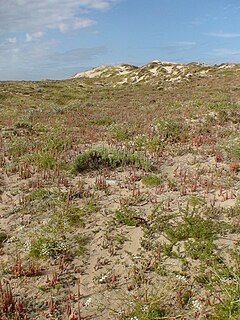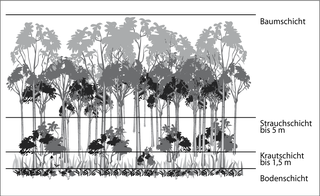A lithosere (a sere originating on rock) is a plant succession that begins life on a newly exposed rock surface, such as one left bare as a result of glacial retreat, tectonic uplift as in the formation of a raised beach, or volcanic eruptions. For example, the lava fields of Eldgjá in Iceland where Laki and Katla fissures erupted in the year 935 and the solidified lava has, over time, begun to form a lithosere.

A seral community is an intermediate stage found in ecological succession in an ecosystem advancing towards its climax community. In many cases more than one seral stage evolves until climax conditions are attained. A prisere is a collection of seres making up the development of an area from non-vegetated surfaces to a climax community.

Ecological succession is the process of change in the species structure of an ecological community over time. The time scale can be decades, or even millions of years after a mass extinction.

A glacier is a persistent body of dense ice that is constantly moving under its own weight; it forms where the accumulation of snow exceeds its ablation over many years, often centuries. Glaciers slowly deform and flow due to stresses induced by their weight, creating crevasses, seracs, and other distinguishing features. They also abrade rock and debris from their substrate to create landforms such as cirques and moraines. Glaciers form only on land and are distinct from the much thinner sea ice and lake ice that form on the surface of bodies of water.
Contents
Pioneer species are the first organisms that colonise an area, of which lithoseres are an example. They will typically be very hardy (i.e., they will be xerophytes, wind-resistant or cold-resistant). In the case of a lithosere the pioneer species will be cyanobacteria and algae, which create their own food and water—i.e., they are autotrophic and so do not require any external nutrition (except sunlight). For example, the first lithosere observed after the volcanic explosion of Krakatoa was algae. [1] Other examples of lithoseres include communities of mosses and lichens, as they are extremely resilient and are capable of surviving in areas without soil.
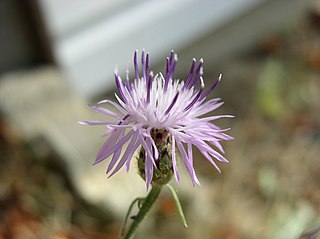
Pioneer species are hardy species which are the first to colonize previously biodiverse steady-state ecosystems. Some lichens grow on rocks without soil, so may be among the first of life forms, and break down the rocks into soil for plants. Since some uncolonized land may have thin, poor quality soils with few nutrients, pioneer species are often hardy plants with adaptations such as long roots, root nodes containing nitrogen-fixing bacteria, and leaves that employ transpiration. Note that they are often photosynthetic plants, as no other source of energy except light energy is often available in the early stages of succession, thus making it less likely for a pioneer species to be non-photosynthetic. The plants that are often pioneer species also tend to be wind-pollinated rather than insect-pollinated, as insects are unlikely to be present in the usually barren conditions in which pioneer species grow; however, pioneer species tend to reproduce asexually altogether, as the extreme or barren conditions present make it more favourable to reproduce asexually in order to increase reproductive success rather than invest energy into sexual reproduction. Pioneer species will die creating plant litter, and break down as "leaf mold" after some time, making new soil for secondary succession, and nutrients for small fish and aquatic plants in adjacent bodies of water.

In biology, an organism is any individual entity that exhibits the properties of life. It is a synonym for "life form".
A xerophyte is a species of plant that has adaptations to survive in an environment with little liquid water, such as a desert or an ice- or snow-covered region in the Alps or the Arctic. Popular examples of xerophytes are cacti, pineapple and some Gymnosperm plants.
As more mosses and lichens colonize the area, they, along with natural elements such as wind and frost shattering, begin to weather the rock down. This over time creates more soil, leading to increased water retention. Early on, when there is little water, lichens dominate as they are more suited to a lack of water; but as water retention increases, mosses become more dominant as they are faster growing, and these further break the rocks down. The amount of soil is also increased by the decaying mosses and lichens. This improves the fertility of the soil as humus is increased, allowing grasses and ferns to colonise. Over time, flowering plants will emerge, followed by shrubs. As the soil gets progressively deeper, larger and more advanced plants are able to grow. This is the case in Surtsey, a "new", small volcanic island located off the south coast of Iceland. Surtsey was "created" in the 1960s and currently its plant succession has reached the stage where ferns and grasses have begun to start growing in the south of the island where the lava cooled first. [2]
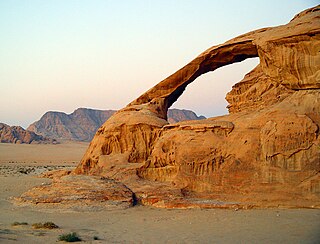
Weathering is the breaking down of rocks, soil, and minerals as well as wood and artificial materials through contact with the Earth's atmosphere, water, and biological organisms. Weathering occurs in situ, that is, in the same place, with little or no movement, and thus should not be confused with erosion, which involves the movement of rocks and minerals by agents such as water, ice, snow, wind, waves and gravity and then being transported and deposited in other locations.
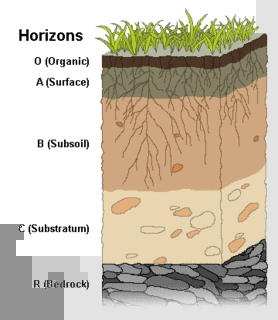
In soil science, humus denominates the fraction of soil organic matter that is amorphous and without the "cellular cake structure characteristic of plants, micro-organisms or animals." Humus significantly affects the bulk density of soil and contributes to its retention of moisture and nutrients.

A fern is a member of a group of vascular plants that reproduce via spores and have neither seeds nor flowers. They differ from mosses by being vascular, i.e., having specialized tissues that conduct water and nutrients and in having life cycles in which the sporophyte is the dominant phase. Ferns have complex leaves called megaphylls, that are more complex than the microphylls of clubmosses. Most ferns are leptosporangiate ferns, sometimes referred to as true ferns. They produce coiled fiddleheads that uncoil and expand into fronds. The group includes about 10,560 known extant species.
As the plant succession develops further, trees start to appear. The first trees (or pioneer trees) that appear are typically fast growing trees such as birch, willow or rowan. In turn these will be replaced by slow growing, larger trees such as ash and oak. This is the climax community on a lithosere, defined as the point where a plant succession does not develop any further—it reaches a delicate equilibrium with the environment, in particular the climate.

A birch is a thin-leaved deciduous hardwood tree of the genus Betula, in the family Betulaceae, which also includes alders, hazels, and hornbeams. It is closely related to the beech-oak family Fagaceae. The genus Betula contains 30 to 60 known taxa of which 11 are on the IUCN 2011 Red List of Threatened Species. They are a typically rather short-lived pioneer species widespread in the Northern Hemisphere, particularly in northern areas of temperate climates and in boreal climates.

Willows, also called sallows and osiers, form the genus Salix, around 400 species of deciduous trees and shrubs, found primarily on moist soils in cold and temperate regions of the Northern Hemisphere. Most species are known as willow, but some narrow-leaved shrub species are called osier, and some broader-leaved species are referred to as sallow. Some willows are low-growing or creeping shrubs; for example, the dwarf willow rarely exceeds 6 cm (2.4 in) in height, though it spreads widely across the ground.

The rowans or mountain-ashes are shrubs or trees in the genus Sorbus of the rose family, Rosaceae. They are native throughout the cool temperate regions of the Northern Hemisphere, with the highest species diversity in the mountains of western China and the Himalaya, where numerous apomictic microspecies occur. The name rowan was originally applied to the species Sorbus aucuparia and is also used for other species in Sorbus subgenus Sorbus.
In the off chance of a phenomenon which effectively removes most of the lifeforms in these areas, the resultant landscape is considered to be a disclimax, where there is a loss of the previous climax community. Factors which interrupt succession include: human intervention (plagioclimax), change in relief of land (topoclimax), change in animal species (biotic climax) or change in soil such as an increase in acidity (edaphic climax) . In most cases, should the area be left to regenerate as normal when the limiting factor is removed, the area eventually becomes a climax community again (secondary succession).








